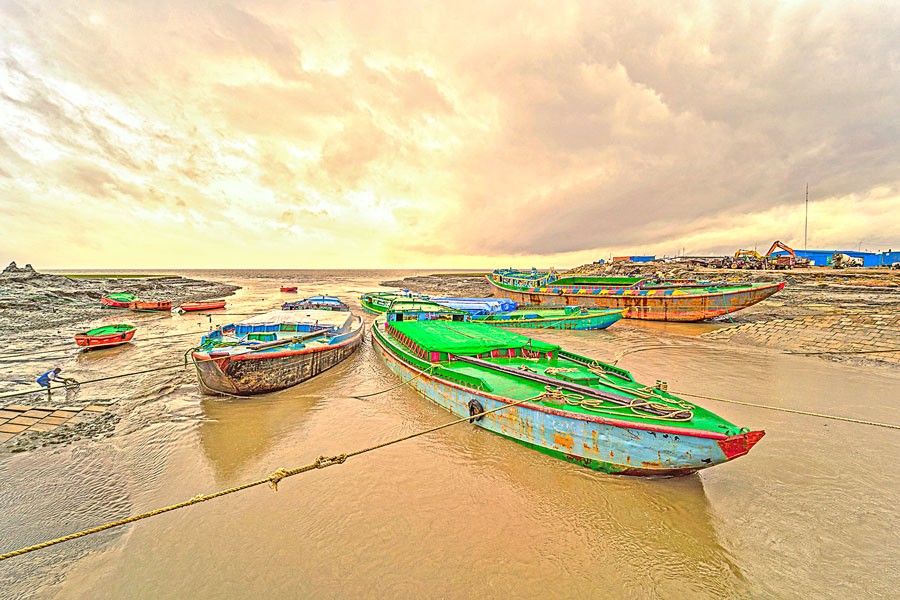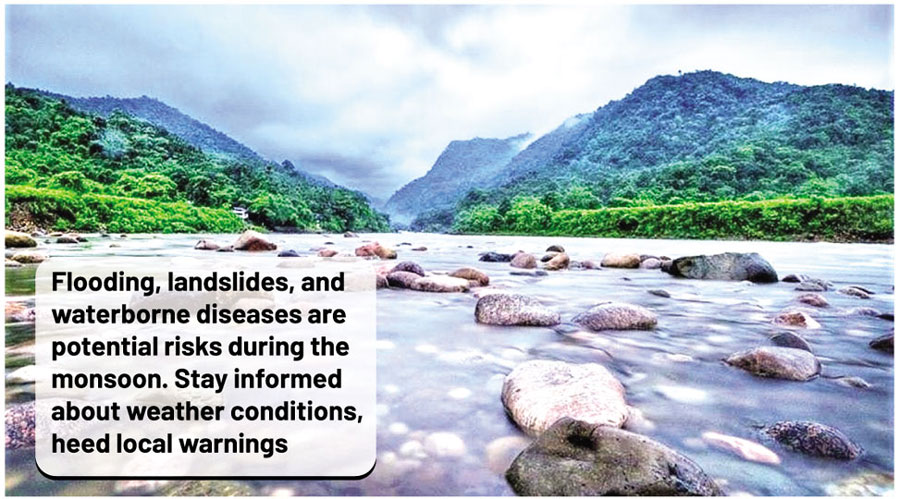 Before rain, from Mirsharai. Photo: Md. Maswoodul Islam/Patachitra
Before rain, from Mirsharai. Photo: Md. Maswoodul Islam/Patachitra  Rain has the magical power of romanticising nature-be it melancholic or joyful. Adventurers can't help themselves answering that call. In Bangladesh, the monsoon typically lasts from June to September. Drenching the greens and painting the sky with clouds, the monsoon transforms the countryside into a paradise on earth.
Rain has the magical power of romanticising nature-be it melancholic or joyful. Adventurers can't help themselves answering that call. In Bangladesh, the monsoon typically lasts from June to September. Drenching the greens and painting the sky with clouds, the monsoon transforms the countryside into a paradise on earth.
While the rains bring life-giving waters to the land, they also present unique challenges for travellers. During the monsoon, Bangladesh experiences torrential rains, high humidity, and frequent thunderstorms. While the downpours can disrupt plans, they also create a serene atmosphere and offer a chance to witness the country's natural beauty at its peak.
However, you must maintain some basics to maximise your monsoon adventure. Sumia Zahid is a traveller who almost always has a trip every year. She prefers the monsoon for her travelling adventures. "I do not take extra precautions. But I take one or two quick-dry dresses. I keep extra poly in my bag to carry wet dresses whenever I travel, in all seasons, but I use it only in the monsoon." If you are planning a tour outside Dhaka before the monsoon ends, here's what you must not forget.
Essential packing
Waterproof gear: A good-quality raincoat, umbrella, and waterproof shoes are non-negotiable. Opt for breathable fabrics to stay comfortable in the humid climate. Nuzhat Urmi, a journalist, frequently travels. She said, "My first choice to be prepared for a monsoon trip would be trekking sandals-be it on a hill or by the sea. They help me to walk on the sticky roads."
Reusable water bottle: Keep a durable, leak-proof, reusable water bottle that fits just right in your backpack. Carry an insulated flask to keep your coffee at the desired temperature or a refreshing drink on hand throughout the day.
Warm clothing: Evenings in the hill tracts can be chilly, so pack layers to adjust to changing temperatures at sundown.
Insect repellent: Chances are high that you may get dengue, malaria, allergic reactions to mosquitos, or be bitten by deadly insects. So protect yourself with effective repellent and use a mosquito net while sleeping.
Nuzhat reminded other essentials: "Trekking for a long time gets my dress very soggy. That sweaty dress creates an itchy, uncomfortable feeling. That's why I keep an apple cider vinegar spray with me instead of an alcoholic spray."
First-aid kit: A well-stocked kit is essential for any traveller, but especially during the monsoon, when minor injuries might occur occasionally.
Medicine box: Pack essential medications in a box, including antihistamines for potential allergies, paracetamols, antacids, saline, pain relief ointments, and any personal prescriptions.
Flashlight or headlamp: Power outages are common during heavy rains outside the cities. So matchbox flashlights are must-haves.
Power bank: Keep your devices charged before your journey, as access to electricity might be limited.
Travel insurance: If you can afford it, insurance may provide a safety net. Comprehensive coverage is crucial to protect against unforeseen circumstances.
Waterproof electronics case: To protect your electronic devices from water damage on the trip, put them in a waterproof electronics case. This will ensure your phone, tablet, or e-reader remains safe and dry.
Microfibre towel: Microfiber is a highly absorbent material that dries quickly and takes up minimal space in your backpack. Whether you need to dry off after an unexpected downpour or remove excess moisture, a microfibre towel is an indispensable companion.
Plastic ziplock bags: Use them to store money, tickets, NID, credit cards, important documents, spare clothes, or even snacks.
Travel-sized toiletries: Don't forget to pack a small kit of travel-sized toiletries. Include hand sanitiser, wet wipes, a comb, and a folding brush.
Transportation Tips
Expect delays: Roads can become flooded, disrupting transportation services. So, count extra days for travel.
Avoid night travel: Visibility is significantly reduced during heavy rain, so night driving is hazardous. So it's better to travel in daylight-on the Highway or Hillsides.
Consider alternative routes: Local knowledge can be invaluable in finding detours and avoiding flooded areas.
Boat transportation: In some regions, boats become the primary mode of transport during the monsoon. Be prepared for this option, and avoid getting boat sick.
Expenses
When asked about financial costs, Nuzhat said, "Expenses are comparatively less during the monsoon as it's the off-season, especially during floods. Food and transportation costs don't seem much different. But accommodation costs drop very much in the tourist spots. The weather is so dreamy. Part of why I prefer to travel in the rainy season."
However, travelling is only right during normal floods, which occur every year. Whenever the flood is extreme, like this year's flood, delay plans until the situation improves.
Flooding, landslides, and waterborne diseases are potential risks during the monsoon. Stay informed about weather conditions, heed local warnings, and listen to local advice.
With careful planning and a positive attitude, you can make the most of your monsoon trip in Bangladesh truly unforgettable.
nidrisanan7314@gmail.com
© 2026 - All Rights with The Financial Express
